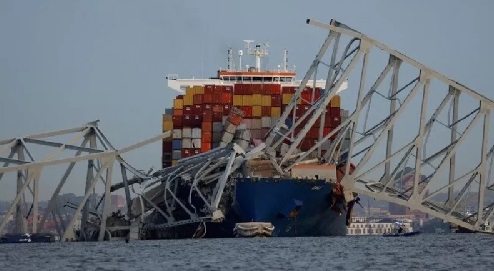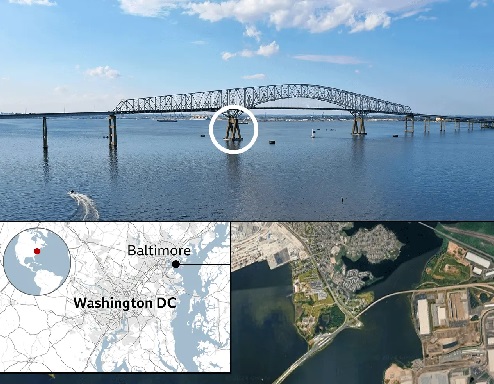
Baltimore Francis Scott Key Bridge collapse: What we know about ship and bridge
Early on Tuesday morning a container ship crashed into the landmark Francis Scott Key Bridge near the US city of Baltimore, causing most of it to collapse.
Advertisement
Several vehicles on the bridge at the time plunged into the waters of the River Patapsco, and rescuers are searching for between seven and 20 people believed to be in the river.
Maryland Governor Wes Moore has declared a state of emergency.
The Baltimore bridge, known more simply as the Key Bridge, was opened in 1977 in honour of Francis Scott Key, a 19th Century Maryland poet who wrote the words for the US national anthem, the Star Spangled Banner.
The bridge was 8,636 feet (2,632m) long and spanned the Patapsco River and Baltimore harbour. The river flows out into Chesapeake Bay, the largest estuary in the US.
It is described as a continuous truss bridge, and its main span of 1,200ft was the third longest of any bridge of its type in the world.
Video footage from the incident appears to show the bridge collapsing instantaneously after the container ship Dali hits one of its pillars. This happened at around 01:30 local time (05:30 GMT) on Tuesday.
Several people were seen to be on the bridge at the time, a fact that was later confirmed by Baltimore Fire Chief James Wallace. Officials later said these included contractors doing repairs to the bridge.
At 01:50 the first fire department unit arrived on the scene and reported the complete collapse of the bridge.
A major search and rescue operation is under way, with divers looking for victims in the icy waters of the harbour and the river.
Officials said there were "some cargo or retainers hanging from the bridge", creating unsafe and unstable conditions, and that emergency rescue teams were operating cautiously as a result.
So far two people have been pulled from the water, one in a serious condition and one apparently uninjured, Mr Wallace said.
The water temperature in the harbour is currently said to be about 9C (48F). Hypothermia can occur when a person's body temperature drops below 35C.
Baltimore fire officials said vehicles had been detected in the water by sonar.
The Singapore-flagged container ship Dali was originally built for Greek shipowner Oceanbulk by South Korea's Hyundai Heavy Industries.
It is currently operated by the charter vessel company Synergy Group and had been temporarily leased by container shipping giant Maersk, a Maersk statement said.
Maersk added that it was carrying cargo for Maersk customers but that no company personnel were on board at the time.
The ship set off from Baltimore's Seagirt Marine Terminal at around 00:24 local time on Tuesday, en route for Colombo, Sri Lanka.
Its speed steadily increased and it maintained a straight route south east along the Patapsco River.
Then at 01:25 MarineTraffic data shows that the ship suddenly diverted from its straight course and began to slow down.
Around this time, video shows that all lights on the exterior of the ship suddenly turned off and smoke began emanating from the ship's funnel.
Shortly afterwards it hit the bridge.
Synergy said the crew, who are all Indian nationals, and the two pilots on board had all been accounted for and there were no reports of any injuries.
The company said there were several possible explanations for the incident but that, with two pilots present, such a crash was unusual.
A shipping expert told the BBC that the crash could have been caused by engine failure, steering failure or generator blackout.
This is not the first incident involving the Dali.
While attempting to leave the port of Antwerp, Belgium in 2016 the ship scraped its stern along the quay damaging the hull. There were no reports of injuries or spillages.
What will be the impact of the bridge's collapse?

The location of the Key Bridge suggests there will be major disruption to road traffic for months and even years to come. Shipping activity in the port of Baltimore will also be severely affected.
The four-lane bridge was part of Interstate 695, the outer ring road around Baltimore city known as the "Baltimore Beltway", and carried an estimated 11.5 million vehicles per year.
It will still be possible to cross Baltimore harbour by tunnel closer to the city, but local authorities have declared a "major traffic alert", anticipating significant traffic problems after the incident.
The bridge's collapse will, in particular, be a major problem for lorries carrying hazardous materials, which were able to cross the bridge but are banned from the alternative tunnel route.
But the incident has created no less of a problem for shipping.
Container shipping expert Lars Jansen said what had happened was a "major disaster" which would "create significant problems on the US East Coast for US importers and exporters".
On top of some 21,000 units of cargo having to go through other ports in the region, he says "multiple merchant vessels are now trapped in the port of Baltimore". None are container ships but there are some bulk carriers.
It is estimated that around 800,000 vehicles passed through the port in 2023, moving a record 1.3 million tons of imported cargo.
However, Mr Jansen says that while there will be some delays and added costs, from a global perspective the incident will not have a significant impact.




